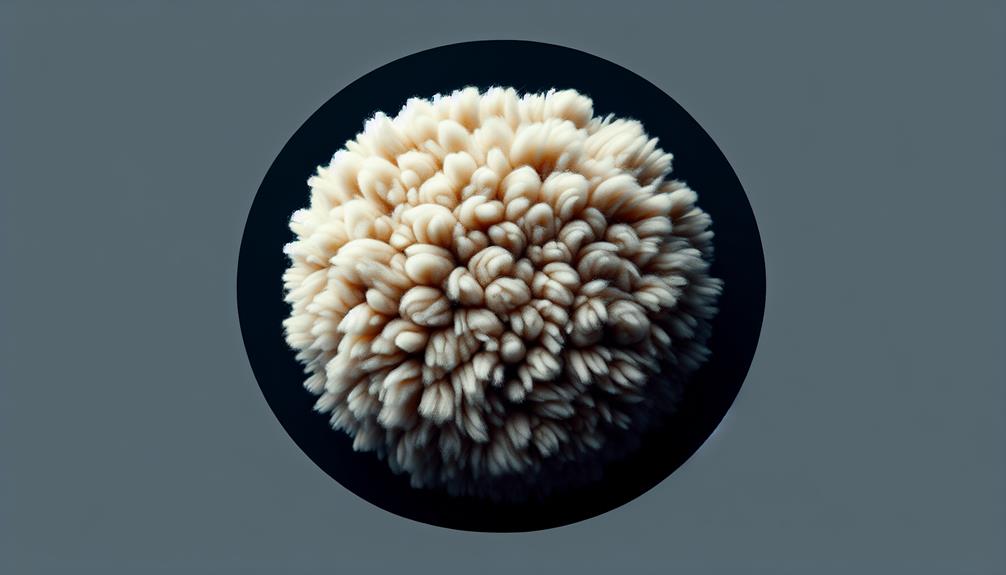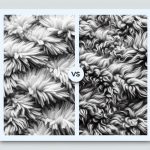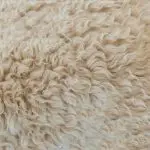Sherpa fabric is an intriguing material; its composition is a blend of natural and synthetic fibers, creating a unique texture that is both soft and durable.
But have you ever wondered about the specific elements that come together to form this cozy material?
Let's explore the intricate details of what makes up Sherpa and how its manufacturing process contributes to its popularity in the world of winter wear.
Table of Contents
Key Takeaways
- Sherpa fabric comprises a blend of natural and synthetic fibers for a soft and durable texture.
- Natural fibers like wool and cotton are used in Sherpa to enhance comfort and sustainability.
- Sustainable elements like plant-based polyesters are incorporated in Sherpa for eco-friendly practices.
- Synthetic fibers in Sherpa offer durability, easy care, and quick-drying properties for various products.
Sherpa Fabric Composition
Sherpa fabric, primarily made of synthetic yarns like acrylic or polyester, provides a soft and fluffy texture reminiscent of wool or sheepskin on the piled side. This unique fabric is known for its plush feel, making it a popular choice for cozy blankets, jackets, and other cold-weather apparel. The synthetic yarns used in Sherpa production give it durability and ease of care, making it a practical option for everyday use.
The wooly side of Sherpa fabric is what sets it apart, offering a luxurious look and feel without the need for animal-derived materials. Despite its synthetic composition, Sherpa maintains the warmth and softness typically associated with natural fibers like wool. The use of synthetic yarns also contributes to Sherpa's affordability and accessibility, making it a versatile choice for a wide range of products.
Natural Fibers in Sherpa
I'll talk about the natural fibers used in Sherpa fabric, such as wool and cotton, and how they contribute to its warmth and durability.
Wool can provide a wooly appearance without using real sheepskin, while cotton blends offer a cozy and insulating material for various applications.
The combination of these natural fibers with synthetic materials results in a Sherpa fabric that's both soft and sustainable.
Wool in Sherpa
Wool in Sherpa fabric enhances its luxurious feel and provides excellent insulation properties, making it a popular choice for cold weather apparel.
Unlike synthetic materials, wool Sherpa blankets offer warmth without sacrificing comfort. The natural fibers in Sherpa make it comfortable to wear and environmentally friendly.
Wool Sherpa mimics the softness and warmth of genuine sheepskin, providing a cozy option for chilly days. Additionally, the incorporation of wool adds a touch of luxury to the fabric, making it a preferred choice for those seeking both style and functionality in their winter wardrobe.
Cotton in Sherpa
Including cotton as one of the natural fibers in Sherpa fabric enhances its texture and feel, providing a natural element to the synthetic material. Cotton fibers in Sherpa may improve moisture-wicking properties, making it a comfortable choice. The blend of natural fibers like cotton in Sherpa adds breathability and softness to the fabric, making it ideal for various uses. Here is a table highlighting the benefits of cotton in Sherpa:
| Benefits of Cotton in Sherpa | |
|---|---|
| Enhanced texture and feel | |
| Improved moisture-wicking properties | |
| Increased breathability | |
| Softness and comfort |
Synthetic Materials in Sherpa
I'll start by highlighting the significance of synthetic fibers in Sherpa fabric, explaining their role in creating a durable and cost-effective material.
We'll also touch on the sustainable aspect of using synthetic materials in Sherpa, considering its environmental impact and how it offers a more animal-friendly alternative.
Let's explore how these synthetic yarns contribute to the unique appearance and texture of Sherpa, resembling sheepskin or wool while being more sustainable in the long run.
Synthetic Fibers in Sherpa
How do synthetic fibers enhance the durability and texture of Sherpa fabric?
Synthetic materials play a crucial role in crafting the cozy and plush Sherpa fleece. Here are three key ways they contribute:
- Durability: Synthetic fibers like polyester and acrylic are known for their strength, making Sherpa fabric long-lasting and resistant to wear and tear.
- Soft Texture: These synthetic materials create a soft pile on one side of the Sherpa, providing a luxurious feel against the skin.
- Affordability: By using synthetic fibers instead of natural materials like wool or fur, Sherpa becomes more cost-effective without compromising on quality or appearance.
Sustainable Fabric Options
Synthetic materials play a significant role in creating sustainable fabric options for Sherpa, particularly through the use of plant-based polyesters by some manufacturers. These plant-based polyesters offer a more environmentally friendly alternative to traditional synthetic fibers, reducing the reliance on fossil fuels in Sherpa production.
This shift towards sustainable fabric options not only benefits the environment but also promotes animal-friendly practices by eliminating the use of real sheepskin. Additionally, the incorporation of synthetic materials enhances the durability of Sherpa fabric, ensuring longevity and wear-resistance.
Environmental Impact Considerations
Moving from the discussion on sustainable fabric options in Sherpa, the environmental impact considerations surrounding the use of synthetic materials like polyester and acrylic in Sherpa production are crucial to understand. When it comes to synthetic yarns in Sherpa fabric, sustainability is a significant concern due to their non-biodegradable nature.
The environmental impact of using polyester and acrylic fibers, derived from non-renewable petroleum sources, raises questions about long-term sustainability. Additionally, the production and disposal of Sherpa fabric made from synthetic materials contribute to environmental pollution and waste, further emphasizing the need for more eco-friendly alternatives like recycled polyester.
Considering these factors is essential in making informed choices regarding the environmental impact of Sherpa production.
Sherpa Manufacturing Process
When I delve into the Sherpa manufacturing process, the intricate techniques of weaving, tufting, circular loops, and sliver knitting come to light as essential steps in creating this cozy fabric.
In the weaving process, fibers are spun into yarn, woven into a base fabric, then sheared, brushed, and bonded to form Sherpa. Tufting involves setting up knitting machines with bulky yarn to create looped fabric, which is then brushed for added texture. These methods are crucial in achieving the soft, warm, and durable characteristics that define Sherpa fabric.
Key Components of Sherpa
One of the key components of Sherpa fabric is its unique blend of synthetic yarns like acrylic or polyester. When it comes to the making of Sherpa, these key components play a crucial role in ensuring the fabric's distinctive qualities.
Here are some essential elements related to Sherpa production:
- Versatile Usage: Sherpa fabric is commonly used in making a variety of items such as clothing, blankets, and sherpa linings. Its softness and warmth make it a popular choice for these applications.
- Durability: The blend of synthetic yarns like acrylic or polyester with other materials like cotton enhances the durability of Sherpa fabric, making it long-lasting and resilient to wear and tear.
- Comfort: Sherpa's unique texture, resembling wool or sheepskin, provides a cozy and luxurious feel, making it ideal for use in clothing, especially in winter garments for added comfort and warmth.
These components are fundamental in creating the beloved Sherpa fabric that many cherish for its warmth and comfort in various products.
Sustainable Elements in Sherpa
To enhance the sustainability of Sherpa fabric, manufacturers incorporate plant-based polyesters in its production. This choice of plant-based polyesters over traditional synthetic fibers adds to the environmentally friendly aspects of Sherpa. The use of these sustainable materials helps reduce the environmental impact of Sherpa production while maintaining the fabric's quality and performance. The synthetic fibers used in Sherpa fabric play a significant role in its sustainable elements, offering durability and longevity. Additionally, the lightweight and breathable nature of Sherpa fabric further contribute to its sustainable characteristics, making it suitable for various products. By utilizing plant-based polyesters and synthetic fibers in its production, Sherpa fabric not only provides a wooly appearance without using real sheepskin but also aligns with sustainable practices.
| Sustainable Elements in Sherpa | |
|---|---|
| Plant-Based Polyesters | Environmentally Friendly |
| Synthetic Fibers | Lightweight |
| Durability | Breathable |
Environmental Impact of Sherpa
How does the production of Sherpa fabric contribute to its environmental impact?
When considering the environmental impact of Sherpa fabric, several key factors come into play:
- The use of synthetic yarns like acrylic or polyester in Sherpa fabric production can lead to a lower environmental impact compared to materials like genuine wool or fur.
- Some manufacturers opt for plant-based polyesters to create Sherpa fabric, introducing sustainability into the production process and reducing the reliance on fossil fuels.
- Sherpa fabric offers an animal-friendly alternative to traditional wool and fleece materials, contributing to a more ethical and sustainable approach to textile production.
Frequently Asked Questions
What Is Real Sherpa Made Of?
Real Sherpa is made from natural wool, often sourced from sheep or goats. It can also come from alpaca or llama wool for a softer feel. The genuine material is prized for its warmth, softness, and durability.
What Is Difference Between Sherpa and Fleece?
Sure thing! The difference between Sherpa and fleece lies in texture and warmth. Sherpa is thicker and more insulating than regular fleece. Sherpa fabric provides extra warmth and comfort, making it ideal for lined clothing and winter wear.
What Animal Makes Sherpa?
Sherpa fabric is not made from animals; it's a synthetic material. It mimics wool's warmth and softness without animal cruelty. The fluffy texture comes from synthetic fibers, providing a vegan-friendly option that's cozy and ethical.
Why Is Sherpa so Expensive?
Sherpa fabric can be pricey due to the intricate manufacturing processes like twisting yarns and brushing. Its demand for lined clothing and winter wear also impacts its cost. The quality materials used justify the higher price.
- Tetron Fabric for Marine Applications: Durability and Use Cases - June 18, 2025
- Tetron Fabric for Outdoor Furniture: Weather Resistance and Care - June 18, 2025
- Tetron Fabric for Wall Coverings: Style and Application Tips - June 18, 2025







